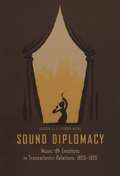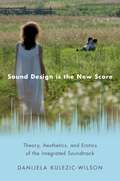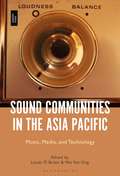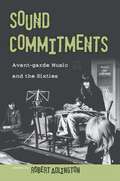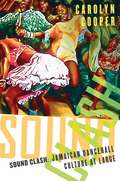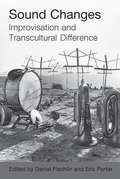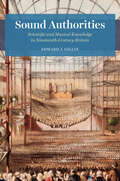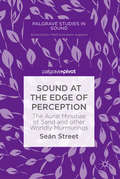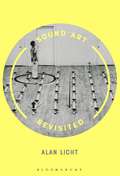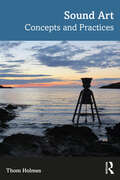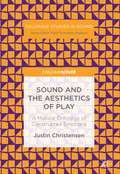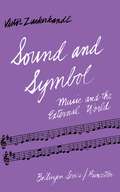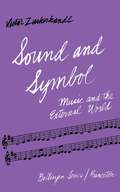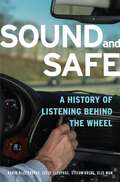- Table View
- List View
Sound Diplomacy: Music and Emotions in Transatlantic Relations, 1850-1920
by Jessica C. Gienow-HechtThe German-American relationship was special long before the Cold War; it was rooted not simply in political actions, but also long-term traditions of cultural exchange that date back to the nineteenth century. Between 1850 and 1910, the United States was a rising star in the international arena, and several European nations sought to strengthen their ties to the republic by championing their own cultures in America. While France capitalized on its art and Britain on its social ties and literature, Germany promoted its particular breed of classical music. Delving into a treasure trove of archives that document cross-cultural interactions between America and Germany, Jessica Gienow-Hecht retraces these efforts to export culture as an instrument of nongovernmental diplomacy, paying particular attention to the role of conductors, and uncovers the remarkable history of the musician as a cultural symbol of German cosmopolitanism. Considered sexually attractive and emotionally expressive, German players and conductors acted as an army of informal ambassadors for their home country, and Gienow-Hecht argues that their popularity in the United States paved the way for an emotional elective affinity that survived broken treaties and several wars and continues to the present.
Sound Diplomacy: Music and Emotions in Transatlantic Relations, 1850-1920
by Jessica C. Gienow-HechtThe German-American relationship was special long before the Cold War; it was rooted not simply in political actions, but also long-term traditions of cultural exchange that date back to the nineteenth century. Between 1850 and 1910, the United States was a rising star in the international arena, and several European nations sought to strengthen their ties to the republic by championing their own cultures in America. While France capitalized on its art and Britain on its social ties and literature, Germany promoted its particular breed of classical music. Delving into a treasure trove of archives that document cross-cultural interactions between America and Germany, Jessica Gienow-Hecht retraces these efforts to export culture as an instrument of nongovernmental diplomacy, paying particular attention to the role of conductors, and uncovers the remarkable history of the musician as a cultural symbol of German cosmopolitanism. Considered sexually attractive and emotionally expressive, German players and conductors acted as an army of informal ambassadors for their home country, and Gienow-Hecht argues that their popularity in the United States paved the way for an emotional elective affinity that survived broken treaties and several wars and continues to the present.
Sound Diplomacy: Music and Emotions in Transatlantic Relations, 1850-1920
by Jessica C. Gienow-HechtThe German-American relationship was special long before the Cold War; it was rooted not simply in political actions, but also long-term traditions of cultural exchange that date back to the nineteenth century. Between 1850 and 1910, the United States was a rising star in the international arena, and several European nations sought to strengthen their ties to the republic by championing their own cultures in America. While France capitalized on its art and Britain on its social ties and literature, Germany promoted its particular breed of classical music. Delving into a treasure trove of archives that document cross-cultural interactions between America and Germany, Jessica Gienow-Hecht retraces these efforts to export culture as an instrument of nongovernmental diplomacy, paying particular attention to the role of conductors, and uncovers the remarkable history of the musician as a cultural symbol of German cosmopolitanism. Considered sexually attractive and emotionally expressive, German players and conductors acted as an army of informal ambassadors for their home country, and Gienow-Hecht argues that their popularity in the United States paved the way for an emotional elective affinity that survived broken treaties and several wars and continues to the present.
Sound Diplomacy: Music and Emotions in Transatlantic Relations, 1850-1920
by Jessica C. Gienow-HechtThe German-American relationship was special long before the Cold War; it was rooted not simply in political actions, but also long-term traditions of cultural exchange that date back to the nineteenth century. Between 1850 and 1910, the United States was a rising star in the international arena, and several European nations sought to strengthen their ties to the republic by championing their own cultures in America. While France capitalized on its art and Britain on its social ties and literature, Germany promoted its particular breed of classical music. Delving into a treasure trove of archives that document cross-cultural interactions between America and Germany, Jessica Gienow-Hecht retraces these efforts to export culture as an instrument of nongovernmental diplomacy, paying particular attention to the role of conductors, and uncovers the remarkable history of the musician as a cultural symbol of German cosmopolitanism. Considered sexually attractive and emotionally expressive, German players and conductors acted as an army of informal ambassadors for their home country, and Gienow-Hecht argues that their popularity in the United States paved the way for an emotional elective affinity that survived broken treaties and several wars and continues to the present.
Sound Diplomacy: Music and Emotions in Transatlantic Relations, 1850-1920
by Jessica C. Gienow-HechtThe German-American relationship was special long before the Cold War; it was rooted not simply in political actions, but also long-term traditions of cultural exchange that date back to the nineteenth century. Between 1850 and 1910, the United States was a rising star in the international arena, and several European nations sought to strengthen their ties to the republic by championing their own cultures in America. While France capitalized on its art and Britain on its social ties and literature, Germany promoted its particular breed of classical music. Delving into a treasure trove of archives that document cross-cultural interactions between America and Germany, Jessica Gienow-Hecht retraces these efforts to export culture as an instrument of nongovernmental diplomacy, paying particular attention to the role of conductors, and uncovers the remarkable history of the musician as a cultural symbol of German cosmopolitanism. Considered sexually attractive and emotionally expressive, German players and conductors acted as an army of informal ambassadors for their home country, and Gienow-Hecht argues that their popularity in the United States paved the way for an emotional elective affinity that survived broken treaties and several wars and continues to the present.
Sound Diplomacy: Music and Emotions in Transatlantic Relations, 1850-1920
by Jessica C. Gienow-HechtThe German-American relationship was special long before the Cold War; it was rooted not simply in political actions, but also long-term traditions of cultural exchange that date back to the nineteenth century. Between 1850 and 1910, the United States was a rising star in the international arena, and several European nations sought to strengthen their ties to the republic by championing their own cultures in America. While France capitalized on its art and Britain on its social ties and literature, Germany promoted its particular breed of classical music. Delving into a treasure trove of archives that document cross-cultural interactions between America and Germany, Jessica Gienow-Hecht retraces these efforts to export culture as an instrument of nongovernmental diplomacy, paying particular attention to the role of conductors, and uncovers the remarkable history of the musician as a cultural symbol of German cosmopolitanism. Considered sexually attractive and emotionally expressive, German players and conductors acted as an army of informal ambassadors for their home country, and Gienow-Hecht argues that their popularity in the United States paved the way for an emotional elective affinity that survived broken treaties and several wars and continues to the present.
SOUND DESIGN IS THE NEW SCORE OMMS C: Theory, Aesthetics, and Erotics of the Integrated Soundtrack (Oxford Music/Media Series)
by Danijela Kulezic-WilsonThe practice of blurring the line between score and sound design has transformed contemporary film soundscape by challenging not only the long-established hierarchical relationships between dialogue, music, and sound effects, but also the modes of perception shaped by classical soundtrack practices. The methods of this new trend rely on the language of contemporary popular and art music, producing soundtracks in which it is difficult to tell the difference between score and ambient sound, where pieces of electroacoustic music are merged with diegetic sound, sound effects are absorbed into the score or treated as music, and diegetic sound is treated as musique concrète. In Sound Design is the New Score, Kulezic-Wilson explores theoretical, aesthetic, and sensuous dimensions of this new trend, providing a multifaceted portrait of a practice which recognizes the interconnectedness of all soundtrack elements and emphasizes their inherent musicality. The aesthetic concerns of this practice are illuminated through the concept of the aesthetics of reticence which rejects classical narrative and scoring conventions and uses integrated soundtrack strategies to create the space for mystery in art and for individuality in the cinematic experience. The book's emphasis on sensuous and musical aspects of this practice, informed by the feminist discourse on the erotics of art, challenges popular notions about sensory cinema, demonstrating that the sensuousness of film form and its soundscapes is more sophisticated than simply being the result of excessive sensory stimulation facilitated by the use of digital technology or the "intensified" aesthetics it inspires. The discussion is supported by a wide range of case studies from American Independent, Asian, Australian, and European cinemas, including films by Shane Carruth, Claire Denis, Hou Hsiao-Hsien, Harmony Korine, David Michôd, Gus Van Sant, and Peter Strickland.
Sound Design is the New Score: Theory, Aesthetics, and Erotics of the Integrated Soundtrack (Oxford Music/Media Series)
by Danijela Kulezic-WilsonThe practice of blurring the line between score and sound design has transformed contemporary film soundscape by challenging not only the long-established hierarchical relationships between dialogue, music, and sound effects, but also the modes of perception shaped by classical soundtrack practices. The methods of this new trend rely on the language of contemporary popular and art music, producing soundtracks in which it is difficult to tell the difference between score and ambient sound, where pieces of electroacoustic music are merged with diegetic sound, sound effects are absorbed into the score or treated as music, and diegetic sound is treated as musique concrète. In Sound Design is the New Score, Kulezic-Wilson explores theoretical, aesthetic, and sensuous dimensions of this new trend, providing a multifaceted portrait of a practice which recognizes the interconnectedness of all soundtrack elements and emphasizes their inherent musicality. The aesthetic concerns of this practice are illuminated through the concept of the aesthetics of reticence which rejects classical narrative and scoring conventions and uses integrated soundtrack strategies to create the space for mystery in art and for individuality in the cinematic experience. The book's emphasis on sensuous and musical aspects of this practice, informed by the feminist discourse on the erotics of art, challenges popular notions about sensory cinema, demonstrating that the sensuousness of film form and its soundscapes is more sophisticated than simply being the result of excessive sensory stimulation facilitated by the use of digital technology or the "intensified" aesthetics it inspires. The discussion is supported by a wide range of case studies from American Independent, Asian, Australian, and European cinemas, including films by Shane Carruth, Claire Denis, Hou Hsiao-Hsien, Harmony Korine, David Michôd, Gus Van Sant, and Peter Strickland.
Sound Communities in the Asia Pacific: Music, Media, and Technology
by Lonán Ó Briain and Min Yen OngThe popularization of radio, television, and the Internet radically transformed musical practice in the Asia Pacific. These technologies bequeathed media broadcasters with a profound authority over the ways we engage with musical culture. Broadcasters use this power to promote distinct cultural traditions, popularize new music, and engage diverse audiences. They also deploy mediated musics as a vehicle for disseminating ideologies, educating the masses, shaping national borders, and promoting political alliances. With original contributions by leading scholars in anthropology, ethnomusicology, sound studies, and media and cultural studies, the 12 essays this book investigate the processes of broadcasting musical culture in the Asia Pacific. We shift our gaze to the mechanisms of cultural industries in eastern Asia and the Pacific islands to understand how oft-invisible producers, musicians, and technologies facilitate, frame, reproduce, and magnify the reach of local culture.
Sound Communities in the Asia Pacific: Music, Media, and Technology
The popularization of radio, television, and the Internet radically transformed musical practice in the Asia Pacific. These technologies bequeathed media broadcasters with a profound authority over the ways we engage with musical culture. Broadcasters use this power to promote distinct cultural traditions, popularize new music, and engage diverse audiences. They also deploy mediated musics as a vehicle for disseminating ideologies, educating the masses, shaping national borders, and promoting political alliances. With original contributions by leading scholars in anthropology, ethnomusicology, sound studies, and media and cultural studies, the 12 essays this book investigate the processes of broadcasting musical culture in the Asia Pacific. We shift our gaze to the mechanisms of cultural industries in eastern Asia and the Pacific islands to understand how oft-invisible producers, musicians, and technologies facilitate, frame, reproduce, and magnify the reach of local culture.
Sound Commitments: Avant-Garde Music and the Sixties
by Robert AdlingtonThe role of popular music is widely recognized in giving voice to radical political views, the plight of the oppressed, and the desire for social change. Avant-garde music, by contrast, is often thought to prioritize the pursuit of new technical or conceptual territory over issues of human and social concern. Yet throughout the activist 1960s, many avant-garde musicians were convinced that aesthetic experiment and social progressiveness made natural bedfellows. Intensely involved in the era's social and political upheavals, they often sought to reflect this engagement in their music. Yet how could avant-garde musicians make a meaningful contribution to social change if their music remained the preserve of a tiny, initiated clique? In answer, Sound Commitments, examines the encounter of avant-garde music and "the Sixties" across a range of genres, aesthetic positions and geographical locations. Through music for the concert hall, tape and electronic music, jazz and improvisation, participatory "events," performance art, and experimental popular music, the essays in this volume explore developments in the United States, France, West Germany, Italy, the Netherlands, the Soviet Union, Japan and parts of the "Third World," delving into the deep richness of avant-garde musicians' response to the decade's defining cultural shifts. Featuring new archival research and/or interviews with significant figures of the period in each chapter, Sound Commitments will appeal to researchers and advanced students in the fields of post-war music, cultures of the 1960s, and the avant-garde, as well as to an informed general readership.
Sound Clash: Jamaican Dancehall Culture at Large
by C. CooperMegawattage sound systems have blasted the electronically-enhanced riddims and tongue-twisting lyrics of Jamaica's dancehall DJs across the globe. This high-energy raggamuffin music is often dismissed by old-school roots reggae fans as a raucous degeneration of classic Jamaican popular music. In this provocative study of dancehall culture, Cooper offers a sympathetic account of the philosophy of a wide range of dancehall DJs: Shabba Ranks, Lady Saw, Ninjaman, Capleton, Buju Banton, Anthony B and Apache Indian. Cooper also demonstrates the ways in which the language of dancehall culture, often devalued as mere 'noise,' articulates a complex understanding of the border clashes which characterize Jamaican society, and analyzes the sound clashes that erupt in the movement of Jamaican dancehall culture across national borders.
Sound Changes: Improvisation and Transcultural Difference
by Daniel Fischlin Eric PorterSound Changes responds to a need in improvisation studies for more work that addresses the diversity of global improvisatory practices and argues that by beginning to understand the particular, material experiences of sonic realities that are different from our own, we can address the host of other factors that are imparted or sublimated in performance. These factors range from the intimate affect associated with a particular performer’s capacity to generate a distinctive “voicing,” or the addition of an unexpected sonic intervention only possible with one particular configuration of players in a specific space and time. Through a series of case studies drawn from Africa, Asia, the Americas, and Oceania, Sound Changes offers readers an introduction to a range of musical expressions across the globe in which improvisation plays a key role and the book demonstrates that improvisation is a vital site for the production of emergent social relationships and meanings. As it does this work, Sound Changes situates the increasingly transcultural dimensions of improvised music in relation to emergent networks and technologies, changing patterns of migration and immigration, shifts in the political economy of music, and other social, cultural, and economic factors. Improvisation studies is a recently developed, but growing, interdisciplinary field of study. The discipline—which has only truly come into focus in the early part of the twenty-first century—has been building a lexicon of key terms and developing assumptions about core practices. Yet, the full breadth of improvisatory practices has remained a vexed, if not impossibly ambitious, subject of study. This volume offers a step forward in the movement away from critical tendencies that tend to homogenize and reduce practices and vocabularies in the name of the familiar.
Sound Authorities: Scientific and Musical Knowledge in Nineteenth-Century Britain
by Edward J. GillinSound Authorities shows how experiences of music and sound played a crucial role in nineteenth-century scientific inquiry in Britain. In Sound Authorities, Edward J. Gillin focuses on hearing and aurality in Victorian Britain, claiming that the development of the natural sciences in this era cannot be understood without attending to the study of sound and music. During this time, scientific practitioners attempted to fashion themselves as authorities on sonorous phenomena, coming into conflict with traditional musical elites as well as religious bodies. Gillin pays attention to sound in both musical and nonmusical contexts, specifically the cacophony of British industrialization. Sound Authorities begins with the place of acoustics in early nineteenth-century London, examining scientific exhibitions, lectures, spectacles, workshops, laboratories, and showrooms. He goes on to explore how mathematicians mobilized sound in their understanding of natural laws and their vision of a harmonious ordered universe. In closing, Gillin delves into the era’s religious and metaphysical debates over the place of music (and humanity) in nature, the relationship between music and the divine, and the tensions between spiritualist understandings of sound and scientific ones.
Sound Authorities: Scientific and Musical Knowledge in Nineteenth-Century Britain
by Edward J. GillinSound Authorities shows how experiences of music and sound played a crucial role in nineteenth-century scientific inquiry in Britain. In Sound Authorities, Edward J. Gillin focuses on hearing and aurality in Victorian Britain, claiming that the development of the natural sciences in this era cannot be understood without attending to the study of sound and music. During this time, scientific practitioners attempted to fashion themselves as authorities on sonorous phenomena, coming into conflict with traditional musical elites as well as religious bodies. Gillin pays attention to sound in both musical and nonmusical contexts, specifically the cacophony of British industrialization. Sound Authorities begins with the place of acoustics in early nineteenth-century London, examining scientific exhibitions, lectures, spectacles, workshops, laboratories, and showrooms. He goes on to explore how mathematicians mobilized sound in their understanding of natural laws and their vision of a harmonious ordered universe. In closing, Gillin delves into the era’s religious and metaphysical debates over the place of music (and humanity) in nature, the relationship between music and the divine, and the tensions between spiritualist understandings of sound and scientific ones.
Sound at the Edge of Perception: The Aural Minutiae of Sand and other Worldly Murmurings (Palgrave Studies in Sound)
by Seán StreetThis book is about the tiny sounds of the world, and listening to them, the minute signals that are clues to who and where we are. A very small sound, given the context of its history, becomes hugely significant, and even an imagined sound in a picture becomes almost a voice. By speaking a name, we give a person back to the world, and a breath, a sigh, a laugh or a cry need no language. A phoneme is the start of all stories, and were we able to tune ourselves to the subtleties of the natural world, we might share the super-sensitivity of members of the bird and animal kingdom to sense the message in the apparent silence. Mind hears sound when it perceives an image; the book will appeal to sonic and radio practitioners, students of sound, those working in the visual arts, and creative writers.
Sound at the Edge of Perception: The Aural Minutiae of Sand and other Worldly Murmurings (Palgrave Studies in Sound)
by Seán StreetThis book is about the tiny sounds of the world, and listening to them, the minute signals that are clues to who and where we are. A very small sound, given the context of its history, becomes hugely significant, and even an imagined sound in a picture becomes almost a voice. By speaking a name, we give a person back to the world, and a breath, a sigh, a laugh or a cry need no language. A phoneme is the start of all stories, and were we able to tune ourselves to the subtleties of the natural world, we might share the super-sensitivity of members of the bird and animal kingdom to sense the message in the apparent silence. Mind hears sound when it perceives an image; the book will appeal to sonic and radio practitioners, students of sound, those working in the visual arts, and creative writers.
Sound Art Revisited
by Alan LichtThe first edition of Sound Art Revisited (published as Sound Art: Beyond Music, Between Categories) served as a groundbreaking work toward defining this emerging field, and this fully updated volume significantly expands the story to include current research since the book's initial release. Viewed through a lens of music and art histories rather than philosophical theory, it covers dozens of artists and works not found in any other book on the subject. Locating sound art's roots across the centuries from spatialized church music to the technological developments of radio, sound recording, and the telephone, the book traces the evolution of sound installations and sound sculpture, the rise of sound art exhibitions and galleries, and finally looks at the critical cross-pollination that marks some of the most important and challenging art with and about sound being produced today.
Sound Art Revisited
by Alan LichtThe first edition of Sound Art Revisited (published as Sound Art: Beyond Music, Between Categories) served as a groundbreaking work toward defining this emerging field, and this fully updated volume significantly expands the story to include current research since the book's initial release. Viewed through a lens of music and art histories rather than philosophical theory, it covers dozens of artists and works not found in any other book on the subject. Locating sound art's roots across the centuries from spatialized church music to the technological developments of radio, sound recording, and the telephone, the book traces the evolution of sound installations and sound sculpture, the rise of sound art exhibitions and galleries, and finally looks at the critical cross-pollination that marks some of the most important and challenging art with and about sound being produced today.
Sound Art: Concepts and Practices
by Thom HolmesSound Art offers the first comprehensive introduction to sound art written for undergraduate students. Bridging and blending aspects of the visual and sonic arts, modern sound art first emerged in the early 20th century and has grown into a thriving and varied field. In 13 thematic chapters, this book enables students to clearly grasp both the concepts behind this unique area of art, and its history and practice. Each chapter begins with an exploration of key ideas and theories, followed by an in-depth discussion of selected relevant works, both classic and current. Drawing on a broad, diverse range of examples, and firmly interdisciplinary, this book will be essential reading for anyone studying or teaching the theory, history, appreciation, or practice of sound art.
Sound Art: Concepts and Practices
by Thom HolmesSound Art offers the first comprehensive introduction to sound art written for undergraduate students. Bridging and blending aspects of the visual and sonic arts, modern sound art first emerged in the early 20th century and has grown into a thriving and varied field. In 13 thematic chapters, this book enables students to clearly grasp both the concepts behind this unique area of art, and its history and practice. Each chapter begins with an exploration of key ideas and theories, followed by an in-depth discussion of selected relevant works, both classic and current. Drawing on a broad, diverse range of examples, and firmly interdisciplinary, this book will be essential reading for anyone studying or teaching the theory, history, appreciation, or practice of sound art.
Sound and the Aesthetics of Play: A Musical Ontology of Constructed Emotions (PDF)
by Justin ChristensenThis book is an interdisciplinary project that brings together ideas from aesthetics, philosophy, psychology, and music sociology as an expansion of German philosopher Hans-Georg Gadamer’s theory on the aesthetics of play. This way of thinking focuses on an ontology of the process of musicking rather than an ontology of discovering fixed and static musical objects. In line with this idea, the author discusses the importance of participation and involvement in this process of musicking, whether as a listener or as a performer. Christensen then goes on to critique and update Gadamer's theory by presenting incompatibilities between it and recent theories of aesthetic emotions and embodiment. He proposes that emotions are ‘constructed’ rather than ‘caused’, that the mind uses a system of ‘filters’ to respond to sonic stimuli and thus constructs (via play) aesthetic feelings and experiences. In turn, this approach provides music with a route into the development of social capital and inter-subjective communication. This work builds on the hermeneutical steps already taken by Gadamer and those before him, continuing his line of thought beyond his work. It will be of great interest to scholars in music aesthetics as well as a variety of other music related fields, including music psychology, philosophy and science and technology studies.
Sound and Symbol, Volume 1: Music and the External World (Bollingen Series (General) #655)
by Victor ZuckerkandlAn approach to music as an instrument of philosophical inquiry, seeking not so much a philosophy of music as a philosophy through music.
Sound and Symbol, Volume 1: Music and the External World
by Victor Zuckerkandl Willard R. TraskAn approach to music as an instrument of philosophical inquiry, seeking not so much a philosophy of music as a philosophy through music.
Sound and Safe: A History of Listening Behind the Wheel
by Karin Bijsterveld Eefje Cleophas Stefan Krebs Gijs MomDo you enjoy listening to music while driving? Do you find radio traffic information indispensable? Do you like to sing along with whatever you like as you drive? This book tells the fascinating story of how, over the course of the twentieth century, we turned automobiles from intentionally noisy contraptions into spheres of auditory privacy that make us feel sound and safe. It explains how engineers in the automotive industry found pride in making car engines quieter once they realized that noise stood for inefficiency. And, after the automobile had become a closed vehicle, it follows them as they struggled against sounds audible within the car. The book also traces how noise is linked both to fears - fears of noise-induced fatigue, fears about the danger of the car radio and drivers' attention spans - and to wants, exploring how drivers at one point actually desired to listen to their cars' engines in order to diagnose mechanical problems and how they now appreciate radio traffic information. And it suggests that their disdain for the ever-expanding number of roadside noise barriers made them long for new forms of in-car audio entertainment. This book also allows you to peep behind the scenes of international standardization committees and automotive test benches. What did and does the automotive industry do to secure the sounds characteristic for their brands? Drawing on archives, interviews, beautiful historical automotive ads, and writing from cultural history, science and technology studies, sound and sensory studies, this book unveils the hidden history of an everyday phenomenon. It is about the sounds of car engines, tires, wipers, blinkers, warning signals, in-car audio systems and, ultimately, about how we became used to listening while driving.
